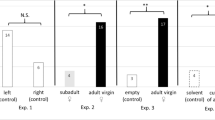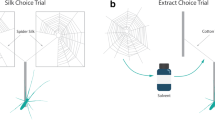Abstract
Chemical signals from female wolf spiders that elicit exploratory behavior and courtship in males are often assumed to be species-specific, but males of some species court in response to silk cues deposited by closely related heterospecific females. Such is the case with the wolf spiders Schizocosa ocreata and S. rovneri, ethospecies reproductively isolated on the basis of differences in behavioral mechanisms during courtship. We explored whether male S. ocreata and S. rovneri reciprocally discriminate species-specific chemical or mechanical cues associated with female silk by using male behavioral response as an assay. Males were exposed to stimulus treatment categories including silk, washed silk, silk extract, and appropriate controls within conspecific or heterospecific female stimulus categories. Male S. ocreata and S. rovneri did not discriminate between conspecific or heterospecific female stimuli, and courtship intensity was greatest on untreated silk. There were no differences in latency to begin courtship or in rates of courtship behaviors attributed to species origin of silk. However, silk treatment (washed silk, extract) had a significant effect on display and exploratory behaviors (e.g., chemoexplore) in both species. Methanol extraction of female silk successfully removed or inactivated a component necessary to elicit active courtship, but extraction did not significantly reduce exploratory behavior, suggesting that a separate compound may be responsible for releasing this behavior. Together, these experiments support the characterization of S.~ocreata and S. rovneri as ethospecies reproductively isolated only by female discrimination of species-specific male courtship, and indicate that chemical, but not mechanical cues associated with silk are critical for eliciting male courtship in both species.
Similar content being viewed by others
REFERENCES
Ayyagari, L. R. and Tietjen, W. J. 1987. Preliminary isolation of male-inhibitory pheromone of the spider Schizocosa ocreata (Araneae, Lycosidae). J. Chem. Ecol. 13:237–245.
Barth, F. G. 2002. A Spider's World: Senses and Behavior. Springer, Heidelberg, Germany.
Cady, A. B. 1984. Microhabitat selection and locomotor activity of Schizocosa ocreata (Walckenaer) (Araneae: Lycosidae). J. Arachnol. 11:297–307.
Costa, F. G. and Capocasale, R. M. 1984. Lycocsa carbonelli, sp. nov.: una etoespecie simpatrida, sibilina de Lycosa thorelli (Keyserling) (Araneae, Lycosidae). J. Arachnol. 11:423–431.
Delaney, K. J. 1997. Communication in the contexts of courtship and aggression in two species on wolf spider (Araneae: Lycosidae). MS Dissertation, University of Cincinnati, Cincinnati.
den Hollander, J. 1971. Species barriers in the Pardosa pullata group/Araneae, Lycosidae/. Proceedings of 5th International Arachnological Congress, Brno, pp. 129–142.
Den Hollander, J. and Dijkstra, H. 1974. Pardosa vlijmi sp. Nov., a new ethospecies sibling Pardosa proxima (C. L. Koch, 1948), from France, with description of courtship display (Araneae, Lycosidae). Beaufortia 22:57–65.
den Hollander, J., Dijkstra, H., Alleman, H., and Vlijm, L. 1973. Courtship behaviour as species barrier in the Pardosa pullata group (Araneae, Lycosidae). Tijdschr. Entomol. 116:1–22.
Dobzhansky, T. 1970. Genetics of the Evolutionary Process. Columbia University Press, New York.
Hegdekar, B. M. and Dondale, C. D. 1969. A contact sex pheromone and some response parameters in lycosid spiders. Can. J. Zool. 47:1–4.
Jackson, R. R. 1987. Comparative study of releaser pheromones associated with silk of jumping spiders (Araneae, Salticidae). N. Z. J. Zool. 14:1–10.
Kaston, B. J. 1936. The senses involved in the courtship of some vagabond spiders. Entomol. Am. 16:97–167.
Kronestedt, T. 1979. Study on chemosensitive hairs in wolf spiders (Araneae, Lycosidae) by scanning electron microscopy. Zool. Scr. 8:279–285.
McClintock, W. J. and Uetz, G. W. 1996. Female choice and pre-existing bias: visual cues during courtship in two Schizocosa wolf spiders (Araneae: Lycosidae). Anim. Behav. 52:167–181.
Miller, G. L., Stratton, G. E., Miller, P. R., and Hebets, E. 1998. Geographic variation in male courtship behaviour and sexual isolation in wolf spiders of the genus Schizocosa. Anim. Behav. 56:937–951.
Papke, M. D., Riechert, S. E., and Schulz, S. 2001. An airborne female pheromone associated with male attraction and courtship in a desert spider. Anim. Behav. 61:877–886.
Polis, G. A. and McCormick, S. J. 1986. Scorpions, spiders, and solpugids: Predation and competition among distantly related taxa. Oecologia 71:111–116.
Pollard, S. D., Macnab, A. M., and Jackson, R. R. 1987. Communication with chemicals: Pheromones and spiders, pp. 133–141, in W. Nentwig (ed.). Ecophysiology of Spiders. Springer, Berlin.
Prouvost, O., Trabalon, M., Papke, M., and Schulz, S. 1999. Contact sex signals on web and cuticle of Tegenaria atrica (Araneae, Agelenidae). Arch. Insect Biochem. Physiol. 40:194–202.
Riechert, S. E. and Singer, F. D. 1995. Investigation of potential male mate choice in a monogamous spider. Anim. Behav. 49:715–723.
Ross, K. and Smith, R. L. 1979. Aspects of the courtship behavior of the black widow spider, Latrodectus hesperus (Araneae: Theridiidae), with evidence for the existence of a contact sex pheromone. J. Arachnol. 7:69–77.
Searcy, L. E., Rypstra, A. L., and Persons, M. H. 1999. Airborne chemical communication in the wolf spider Pardosa milvina. J. Chem. Ecol. 25:2527–2533.
Shaffer, J. P. 1995. Multiple hypothesis testing. Annu. Rev. Psychol. 46:561–584.
Singer, F., Riechert, S. E., Xu, H., Morris, A. W., Becher, E., Hale, J. A., and Noureddine, M. A. 2000. Analysis of courtship success in the funnel-web spider Agelenopsis aperta. Behaviour 137:93–117.
Stratton, G. E. 1997. Investigation of species divergence and reproductive isolation of Schizocosa stridulans (Araneae: Lycosidae) from Illinois. Bull. Br. Arachnol. Soc. 10:313–321.
Stratton, G. E. and Uetz, G. W. 1981. Acoustic communication and reproductive isolation in two species of wolf spiders. Science 214:575–577.
Stratton, G. E. and Uetz, G. W. 1983. Communication via substratum-coupled stridulation and reproductive isolation in wolf spiders (Araneae: Lycosidae). Anim. Behav. 31:164–172.
Stratton, G. E. and Uetz, G. W. 1986. The inheritance of courtship behavior and its role as a reproductive isolating mechanism in two species of Schizocosa wolf spiders (Araneae; Lycosidae). Evolution 40:129–141.
Suter, R. B. and Renkes, G. 1982. Linyphiid spider courtship: releaser and attractant functions of a contact sex pheromone. Anim. Behav. 30:714–718.
Tietjen, W. J. 1977. Dragline-following by male lycosid spiders. Psyche 84:165–178.
Tietjen, W. J. 1979. Is the sex pheromone of Lycosa rabida (Araneae: Lycosidae) deposited on a substratum? J. Arachnol. 6:207–212.
Tietjen, W. J. and Rovner, J. S. 1982. Chemical communication in lycosids and other spiders, pp. 249–279, in P. N. Witt and J. S. Rovner (eds.). Spider Communication. Mechanisms and Ecological Significance. Princeton University Press, Princeton, NJ.
Trabalon, M., Bagneres, A. G., and Roland, C. 1997. Contact sex signals in two sympatric spider species, Tegenaria domestica and Tegenaria pagana. J. Chem. Ecol. 23:747–758.
Uetz, G. W. 2000. Signals and multi-modal signaling in spider communication, pp. 387–405, in Y. Espmark, T. Amundsen, and G. Rosenqvist (eds.). Animal Signals: Signalling and Signal Design in Animal Communication. Tapir Academic Press, Trondheim, Norway.
Uetz, G. W. and Denterlein, G. 1979. Courtship behavior, habitat, and reproductive isolation in Schizocosa rovneri Uetz and Dondale (Araneae: Lycosidae). J. Arachnol. 7:121–128.
Uetz, G. W. and Roberts, J. A. 2002. Multisensory cues and multimodal communication in spiders: Insights from video/audio playback studies. Brain Behav. Evol. 59:222–230.
Wise, D. H. and Chen, B. 1999. Impact of intraguild predators on survival of a forest-floor wolf spider. Oecologia 121:129–137.
Zar, J. H. 1999. Biostatistical Analysis, 4th edn. Prentice Hall, Upper Saddle River, NJ.
Author information
Authors and Affiliations
Rights and permissions
About this article
Cite this article
Roberts, J.A., Uetz, G.W. Chemical Signaling in a Wolf Spider: A Test of Ethospecies Discrimination. J Chem Ecol 30, 1271–1284 (2004). https://doi.org/10.1023/B:JOEC.0000030277.27514.92
Issue Date:
DOI: https://doi.org/10.1023/B:JOEC.0000030277.27514.92




